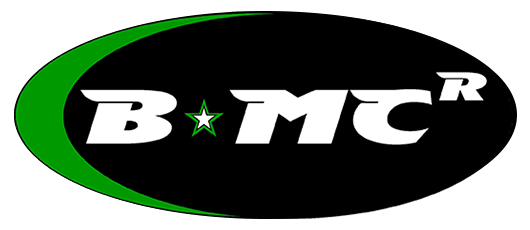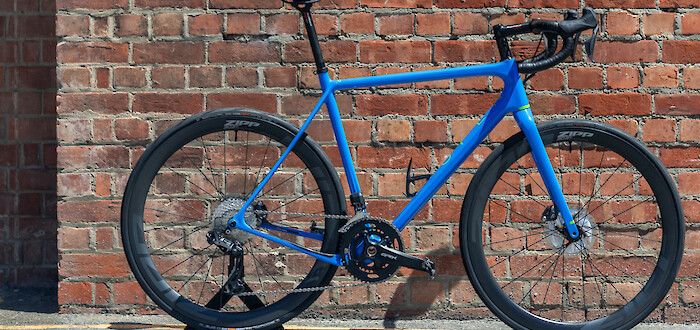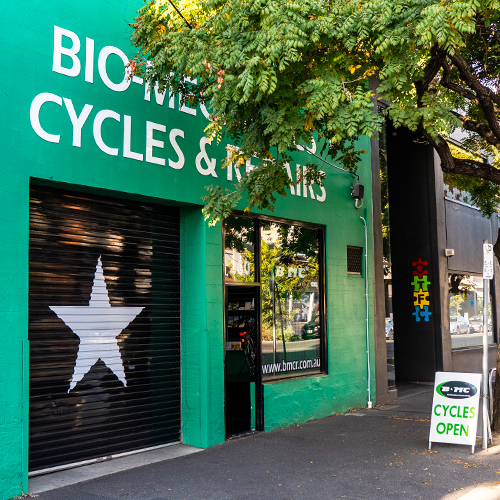The Best Way To Clean Your Bike


The dos and don'ts of bike cleaning
Want to transform your bike from a crunchy, grimy dustbowl into a shiny, smooth-operating machine? Want to save money on your service bill?
It’s easy, and all you need is stuff you probably already have at home.
Yep, it’s time to wash your bike.
(Contain your enthusiasm.)

Cleaning your bike seems like a pretty straightforward process on the surface – soap up, rinse off, lube up, done – but there are several mistakes we see people making which can undo all their good work.
Here’s our easy how-to on all the dos and don’ts of bike cleaning – why to do it, when to do it, and how to do it. And because we love time-saving tips, we’ve also included a secret hack for those times when you just can’t be bothered.
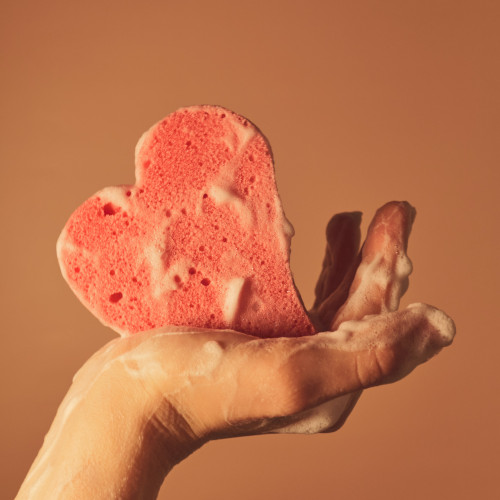
Why should I clean my bike?
It’s important to clean your bike for two critical reasons:
- Your bike will perform better, and feel a lot better to ride.
- Your components will last longer, saving you money.
Less critically, a gleaming bicycle looks a lot better than a dirt-encrusted one, but, hey, not everyone is driven by aesthetics.
You might be surprised that you can feel the difference between riding a clean bike versus a dirty one, but it’s true. A drivetrain that’s gummed up with dirt, grime, road crud and mud feels crunchy to pedal, and won’t change gears properly. Degrease that sucker and you’ll feel an immediate improvement.

The other major downside to a filthy bike is having to replace parts earlier than you should. Dirty components grinding together will wear out faster than clean ones. Gunk and sticky lube combine to become a drivetrain-destroying paste, shredding away bits of cassette and chain ring teeth. By cleaning your drivetrain properly, you’ll get the maximum life out of it, so you can spend your money on other things.
A final often-overlooked note: sweat is a corrosive agent. You wouldn’t think that huffing away on a trainer is going to potentially destroy your bike, but if perspiration build-up isn’t cleaned off, it will basically eat any metal it can find, including bolts, bearings, frames and handlebars. One more reason to keep things clean.

When should I clean my bike?
Clearly, this depends on a) how often you ride it and b) in what conditions.
As a rough guide, if you ride your bike regularly, a monthly clean is a good way to keep things running nicely and stay on top of any potential problems.
This applies to commuters, roadies, mountain bikers -- really, anyone who rides.
Mountain bikes should also always be washed after a muddy ride, paying particular attention to the suspension and pivot bearings.
Outside these guidelines, it’s always a good idea to give your bike (or at least your drivetrain) a scrub if your chain looks mucky or starts to sound crunchy or squeaky.

What products do I need to clean my bike?
To do a proper job, you will need the following bike cleaning tools:
- A hose, preferably with a misting attachment or nozzle
- A sponge
- Rags – get several, as they come in handy for both cleaning and drying
- Brushes – different shapes and sizes will be useful, and an old toothbrush is especially good for getting into tight spots, such as in between cassette (rear) cogs
- Degreaser – your local bike shop will stock dedicated bike degreaser. Failing this, kerosene or turpentine are OK substitutes
- Chain bath or chain cleaner. Don’t have one? Have a chain-breaker and an old (clean) can on hand.
- Soap, automotive detergent or a dedicated bike wash
- A couple of plastic bags
NOTE: Contrary to popular advice, do not use dishwashing liquid to clean your bike.
Dishwashing liquid contains salt, which is an abrasive agent, so you don’t want it anywhere near your frame.
You’re almost ready to begin. However! Before you touch that hose, there are two crucial errors that you’ll want to avoid.
Bike Cleaning Mistake #1 – Getting water inside your frame.

Water is a wonderful thing, except when it’s living in your bike.
Why is it bad to have water inside your bicycle? If you think about it, this is pretty self-evident: water + steel = rust; water + aluminium = corrosion.
A frame that’s corroding from the inside is also harder to notice or fix in time; you may not even realise it’s happening until a hole appears, or the whole thing cracks.
If your bike frame is carbon or titanium, you still want to avoid getting water inside it because that water will eventually make its way into components, especially bearings, and wreak havoc.
Bike Cleaning Mistake #2 – Contaminating your brakes

When using soap, degreaser or lube, you’ll need to be extra-careful not to splash anything onto your brakes. These liquids will be absorbed by the brake pads – hence, contamination. Why is this bad? Well, it means that on your next ride, there’s a very high chance your brakes won’t work properly.
For bikes with disc brakes, you’ll need to make sure to protect the rotors, whereas if you’re running rim brakes, avoid getting anything on the rim’s braking surface.
OK! Let’s get this going.
How do I clean my bike?
The first step is to stop water getting inside it. Take your plastic bags and cover the headset bearings as well as the point where the seat post enters the frame. If you have it, a piece of an old tube slipped over the seat post slot will offer additional protection.
While you’re bagging things up, you’ll also want to cover your seat. Saddles absorb a huge amount of water – a waterlogged bike seat can take days (if not weeks) to dry properly. Seal it off, preferably with at least two layers, to avoid a soggy butt.

Step one: The pre-wash rinse
Got your bearings and saddle covered up? Good.
Put your bike in a bike stand, or, if you don’t have a stand, lean your bike against a wall or tree.
Grab your hose, and gently hose the dirt and crud off.
Note that we say ‘gently’. You are not putting out a fire – do not use a power/jet blast/rocket fuel setting. Too-hard hosing washes away protective grease (e.g. the stuff that’s stopping water getting into bearings), and forces water past seals and components. All of this goes into the interior of your bike.
So don’t blast, but mist, mist, mist away. Be kind to your bicycle.

Step two: The bubble bath
Remove the bags/plastic covering the bearings and seat post, but keep the ones covering your saddle – they’ll stay on until the end.
Get a bucket of warm water and add your chosen soap. (Again, don’t use dishwashing liquid.)
Make sure not to overload your sponge or rag, as that will increase the chances of filling your frame with water.
Wipe over the frame, wheels and cranks with your sponge or rag to get as much dirt and grime off as possible. Be methodical – start from the top and work your way down. Don’t forget to check the underside of the frame, as you’ll typically find a lot of road grime/mud/splatter under the downtube and bottom bracket.
For derailleurs and brakes, use a rag and brush.
Once the bike is dirt-free, grab your hose and gently rinse off the soap with a fine mist.

Step three: Degreasing
NOTE: if you're a dedicated chain-waxer, skip straight to Step Five.
This is where you use your chain bath. Add degreaser, clamp on as per the manufacturer’s instructions, and let the little brushes do their magic.
If you don’t have a chain bath, remove your chain and stick it in a can or container, along with some degreaser or solvent. Now shake it and watch the gunk start flowing out. Drain the dirty liquid, add fresh solvent, and repeat until the solvent remains fairly clean after shaking.
If you don’t have a chain bath and also don’t know how to remove your chain, put some degreaser or solvent in the can, dip an old toothbrush in it and scrub the chain, making sure you get into all the nooks and crannies. Once that’s done, resolve to buy yourself a chain bath next week because the toothbrush method is a pain in the ass.

Step four: Solvent removal
This step is critical.
If you don't get the solvent out of the chain, it'll stay inside the rollers. Once you add lube, it will mix with this leftover solvent and turn into a cutting oil which will chew your chain (and the rest of your drivetrain) to shreds.
Here’s how to avoid this problem.
If you’re using a chain bath, smother the chain in dishwashing liquid (yes, this is the one time you can use it!). Fill your chain bath with clean water, then spin the pedals backwards to work it through properly. See that black stuff coming out? That's solvent and residual contaminants. Refresh the water and keep repeating until there’s nothing else leaching out of the chain.
If you’ve been using the can method, add some very hot, very soapy water to the chain in the can and shake it. Rinse and repeat as above.
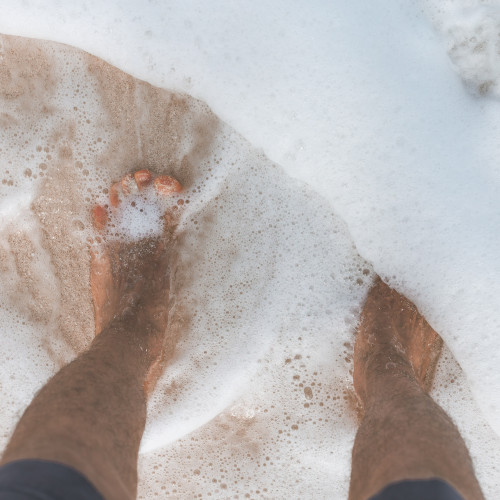
Once the chain has stopped purging gunk, rinse off the soap with boiling water until the chain is clean and shiny.
Leave it in the sun to dry off.
Step five: Finishing the drivetrain
Your chain is clean, so now what? It’s time to tackle your chain rings, cassette and jockey wheels. If you can take them off the bike, do so. If you don't have the right tools, just remove the rear wheel and lean it so the cassette is angled towards the ground – this way degreaser/solvent won't run into the bearings.
Get a stiff-bristled brush and your solvent, then give your cassette a good scrubbing.
Next, do the same for the chain rings (again, if they’re on the bike, make sure to angle them away from the crank bearings) and the jockey wheels.
Now wash with hot, soapy water, then rinse with boiling clean water.
Congratulations: your drivetrain is now clean.
If you can’t be bothered degreasing, cheat.

Too tired to scrub? Pressed for time? Just not in the mood? Then over-lube your chain, let it soak overnight, and buff off the excess the next day.
Although it isn't perfect, it's much better than degreasing improperly or doing nothing at all.
Alternately, if you use a drip-on wax-based lube such as Smoove, you won't need to bother with degreasing in the first place. The downside is that the lubricants don't last as long, so you'll need to make sure you keep on top of your chain maintenance.
Step six: It’s dryin’ time
Most people start towelling off their bike at this point. While this is OK, it’s not the best method.
A better option is to first bounce your bike on its tyres a few times. This will help shake excess water off/out of the frame.
Once you’ve bounced, remove the seat and post from the frame (don’t forget to mark your saddle height with a ziptie or piece of tape first) and put them in a sunny spot to dry out.
Now get a clean rag or towel and start drying the bike. This is the perfect time to inspect the frame welds and components for cracks and/or signs of wear.
Give the bike a final bounce to make sure there's no water trapped anywhere. To make absolutely sure there’s no liquid left inside, rotate the frame. Turn the bike upside-down – is there water coming out of the seat tube? If so, remind yourself about the gentle misting thing.
Keep rotating and shaking the frame until it's water-free.
Now leave it in a warm and/or sunny spot for as long as possible to help the rest of the water evaporate and reduce the chances of corrosion-related problems.
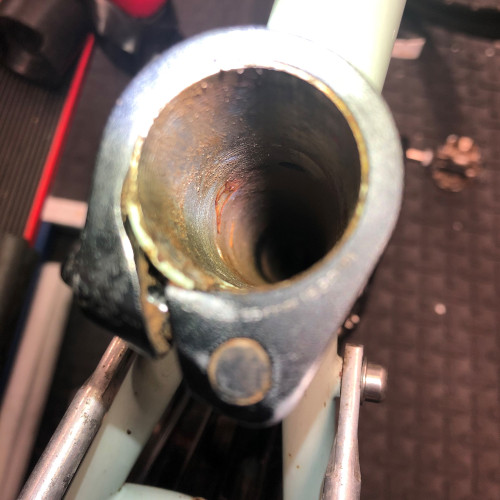
This is a good time to check your brake pads, and rotors, if your bike has them. Make sure that nothing has splashed onto them during the cleaning process. If you’re at all in doubt about whether they’re OK, clean the rotors and brake pads by washing the surfaces down with alcohol or brake cleaner and a clean rag.
Once everything’s nice and dry, reassemble your bike and lube the chain. And you’re done.
Wait, you’ve got more questions? Well, sure.

How do I clean rust from a bike chain?
If the rust isn’t too bad, degreaser can sometimes take care of it for you. If the degreasing process doesn’t shift it, try giving it a scrub with some WD40 and a wire brush.
That being said, a completely rusted chain can be more trouble to clean than it’s worth, so consider just replacing it.
How do I clean sticky handlebar grips?
Rubber breaks down over time with use and also from UV exposure. How successfully you can clean your grips will be partially dictated by whether they’re perished or just dirty.
If they’re dirty, the safest option is to simply use soap and water. If they’re really dirty, you might need to resort to brake cleaner. Use a rag with either method; paper towels will just shred themselves and stick to the rubber, making an even bigger mess.
If they’re too far gone, it might be time for some new ones. Hey, at least they’re cheap.
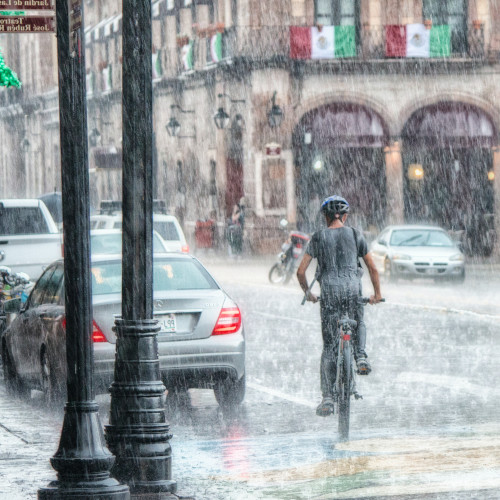
How do I clean a bike after the rain?
Rain is notorious for getting grime and gunk into chains, so get a thick rag or towel, clamp it around the chain with one hand and back-pedal with the other to remove the worst of the grime. If it’s really bad, follow the steps for degreasing. Make sure to lube the chain again afterwards.
For the frame, just give it a wipe down with a clean, dry rag or towel.
How do I clean a carbon fibre bike?
The same way you clean any other bike.
AND NO DISHWASHING LIQUID.

And there’s your how-to on bike cleaning – what to do, and, importantly, what not to do.
Your bike is now sparkling clean, your gears will feel much better, and you’ve just saved yourself a bunch of cash in prematurely worn components.
Go and have a celebratory beer or kombucha, if kombucha is still a thing. And remember to put a reminder in your phone to wash your bike every month or so, just to keep on top of it.

Suspect you may have rust issues? Can't work out how to operate your chain bath? Let us do the hard work for you.
